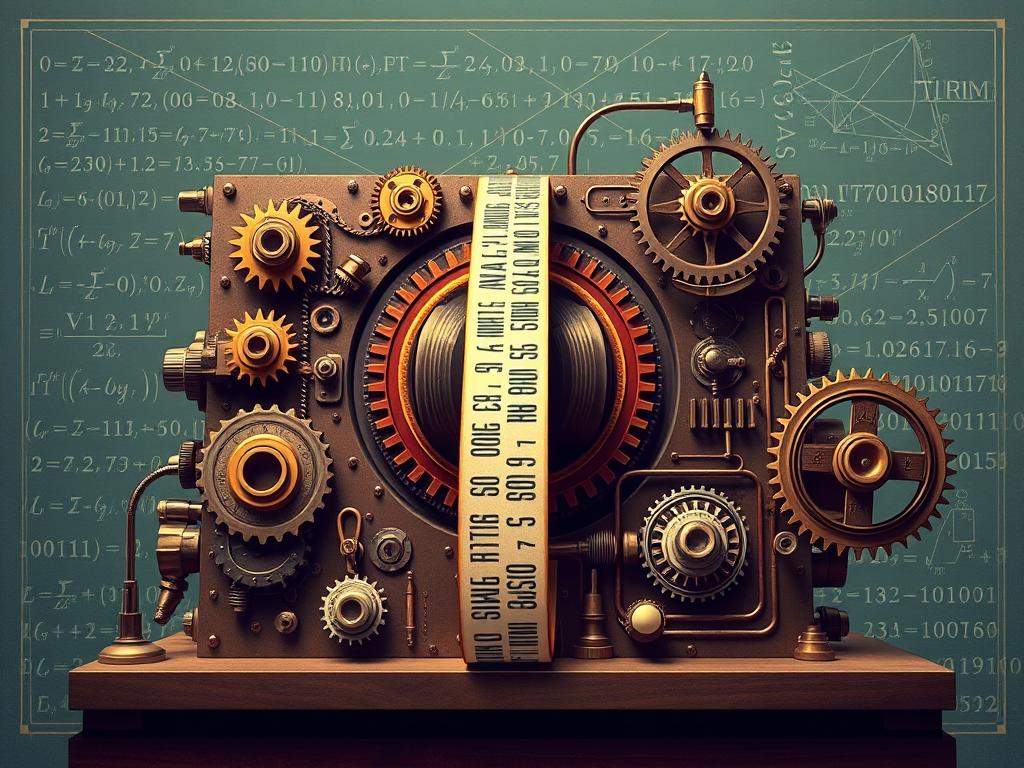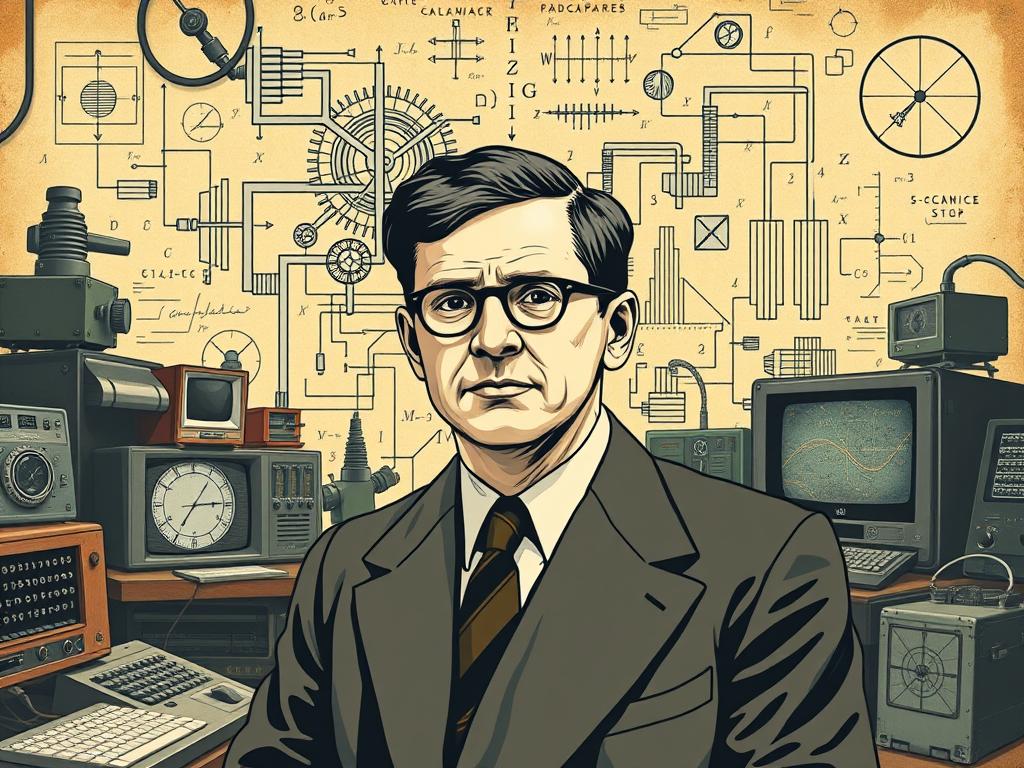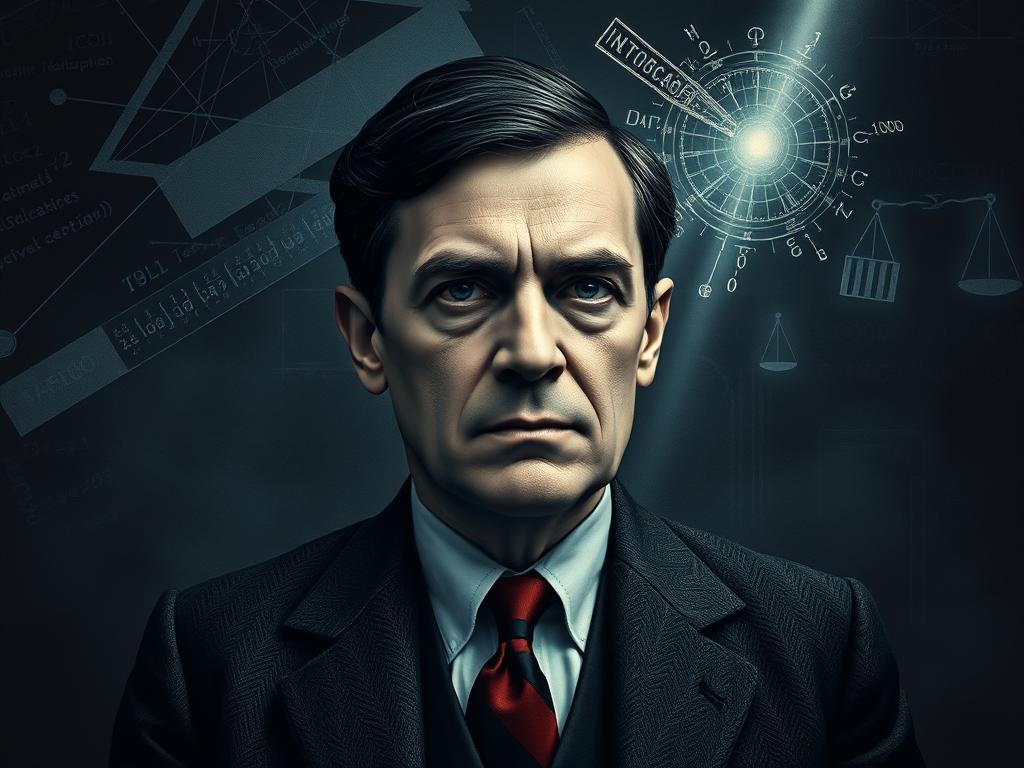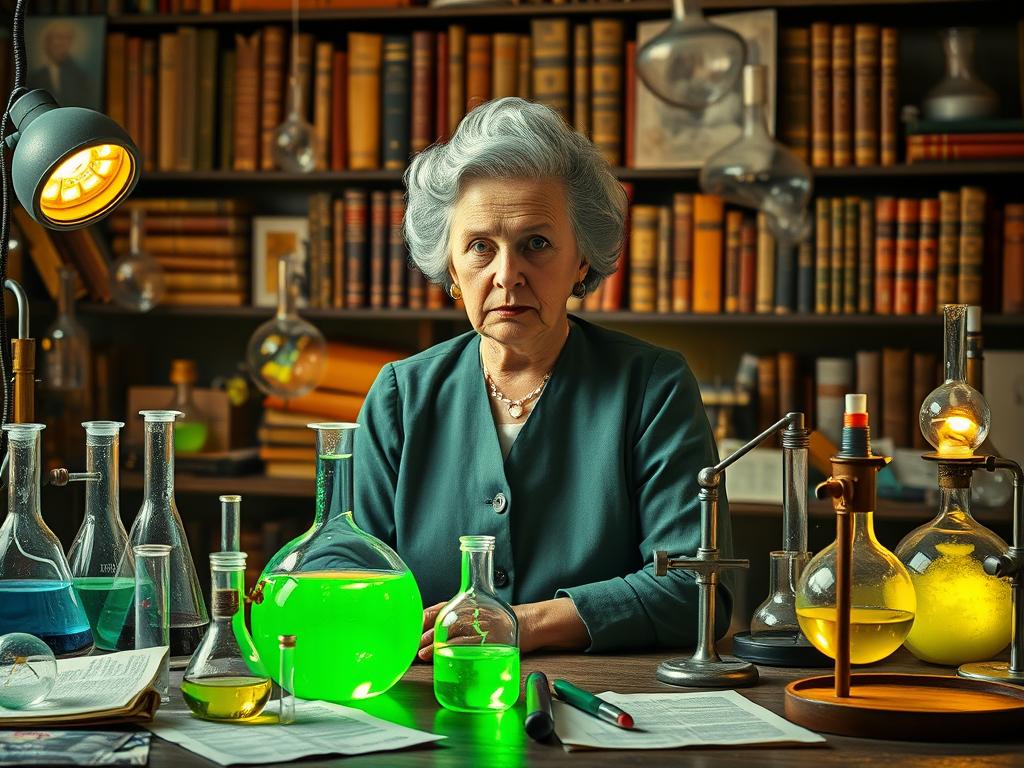Standing before Bletchley Park’s weathered walls, a shiver runs down my spine. This place, once secret, echoes with Alan Turing’s genius. His work here changed history.
Born in London in 1912, Turing was meant for greatness. His codebreaking saved lives and shortened the war. The Bombe machine, Turing and Welchman’s creation, cracked German Air Force signals from 1940.
Turing’s work went beyond WWII. His universal Turing machine started modern computing. But, his life was also marked by persecution. Arrested in 1952 for being gay, Turing died in 1954.
Turing’s WWII work was huge. By 1943, his machines at Bletchley Park decoded 84,000 Enigma messages monthly. This could have saved 14 to 21 million lives. Turing’s story shows the power of human mind and the harm of intolerance.
Early Life and Education
Alan Turing was born in London, England, on June 23, 1912. His early years were filled with learning that would shape his future. Turing’s curiosity in Paddington was the start of his journey to greatness.
Childhood in London
Turing showed his brilliance from a young age in London. His love for math was clear, hinting at his future achievements. These early years helped develop his analytical mind.
Academic Journey at Cambridge
In 1931, Turing started his studies at King’s College, Cambridge. He excelled in math, impressing his professors. His time at Cambridge was filled with innovative ideas that changed computing.
Mathematical Studies and Their Impact
Turing’s studies at Cambridge deeply influenced his work. In 1935, he took Max Newman’s course, inspiring his famous paper “On Computable Numbers.” This paper introduced the Turing machine, a key concept in computer science.
- Graduated from Cambridge in 1934
- Elected to a fellowship at King’s College for research in probability theory
- Published seminal paper in 1936
- Continued studies at Princeton University from 1936 to 1938
Turing’s education and achievements paved the way for his career. His work in fields like AI and cryptography made him a pioneer of the digital age.
Contributions to Mathematics
Alan Turing changed mathematics a lot. His work started modern computing and changed logic. His ideas still shape how we see computation and its limits.
Introduction of Turing Machines
In 1936, Turing came up with Turing machines. These ideas are key to computer science. Turing machines can do any computer task, no matter how hard.
This idea showed what can be done by computers. It opened doors for more computer tech.

Advancements in Computability Theory
Turing’s work made computability theory better. He looked at what can be solved by computers. His research showed what computers can and can’t do.
This was key to understanding computers’ limits.
Turing’s Role in Mathematical Logic
In logic, Turing made big steps. His work linked math to solving real problems. Turing’s ideas helped artificial intelligence and machine learning grow.
His work still helps research today.
- Defined computable numbers
- Solved the Entscheidungsproblem
- Developed the Turing test for machine intelligence
Turing’s work lives on. His ideas are the heart of computer science. They keep inspiring new math and computer discoveries.
Codebreaking During World War II
Alan Turing joined Bletchley Park in 1939. This secret place was where British codebreakers worked hard. Turing’s smart thinking was key in fighting German secrets.
The Enigma Challenge
The German military used the Enigma code for their messages. This code was very hard for the Allies to crack. Turing and his team worked hard to solve it, hoping it would change the war’s outcome.
The Bombe Machine
Turing created the Bombe machine. It made breaking Enigma codes much faster. By 1943, Turing’s machines were decoding 84,000 messages every month.
Breaking the U-boat Enigma
Turing cracked the U-boat Enigma code himself. This was a big win for the Allies in the Battle of the Atlantic. His work helped ships avoid German submarines, saving many lives and supplies.
Turing’s work at Bletchley Park shortened the war by two to four years. His genius and dedication to his country are still remembered today. His work also shapes modern cryptography and computer science.
Personal Life and Identity
Alan Turing’s life was full of both brilliance and struggle. He was born in 1912. His journey as an LGBTQ+ pioneer started at King’s College, Cambridge.
It was there that he found out he was gay. This discovery set him on a path of living in secret.
LGBTQ+ Pioneer
Turing’s sexuality greatly influenced his life. In Britain, being gay was illegal back then. He had to keep his true self hidden, facing many dangers.
Relationships and Social Interactions
Despite the risks, Turing found love. He met Christopher Morcom at Sherborne School. They were close until Morcom died in 1930.
This loss deeply affected Turing. It changed his work and personal life forever.
Turing was a genius in math and codebreaking. But, in 1952, he was caught and charged with “gross indecency.” This led to chemical castration and the loss of his security clearance.
His treatment was so harsh that Turing took his own life in 1954. He was just 41 years old.
In 2009, Prime Minister Gordon Brown apologized for Turing’s treatment. In 2013, Queen Elizabeth II gave him a posthumous pardon. Today, Turing is celebrated for his work and his courage as an LGBTQ+ pioneer.
Recognition and Awards
Alan Turing’s work in computing and cryptography was finally recognized. His work at Bletchley Park during World War II was kept secret. This secrecy delayed public recognition of his contributions for decades.
Posthumous Recognition
In the 1970s, Turing’s code-breaking work became known. This sparked a new interest in his life and work. The British government gave him an OBE in 1945 for his wartime efforts.
Influence on Computing
The computing world honors Turing with the Turing Awards. This award is the highest honor in computer science. It was started in 1966 and now comes with a $1 million prize.
Notable winners include Yoshua Bengio, Geoffrey Hinton, and Yann LeCun. They were honored in 2018 for their work on deep neural networks. Their research has led to big advances in AI.
Turing’s work has a lasting impact. It helped start modern computing and inspired many scientists. The Turing test, proposed by Turing, is key in AI. It tests if machines can think like humans.
Legacy in Computer Science
Alan Turing’s work in computer science still shapes today’s tech. His ideas started computing as we see it now. His 1936 paper, “On Computable Numbers,” introduced the universal Turing machine. This idea changed how we compute.

Foundations of Modern Computing
Turing did more than just theory. In World War II, he worked at Bletchley Park. There, he helped create the Bombe machine to break the German Enigma code. This effort shortened the war by two to four years.
After the war, Turing kept innovating. He worked on the Automatic Computing Engine (ACE) and the Manchester Mark 1. These were early stored-program computers.
Turing Award Significance
The Turing Award is like the “Nobel Prize of Computing.” It was started in 1966 to honor those who changed computer science. This award shows Turing’s lasting impact on computing.
In 2019, Turing was voted the nation’s icon of the 20th century. The Bank of England put him on the new £50 banknote in June 2021. These honors show Turing’s big impact on our world and tech.
The Impact of Artificial Intelligence
Alan Turing’s work started modern AI. His ideas still shape AI and its uses today.
Turing Test: Defining Human-Like Intelligence
In 1950, Turing created the Turing Test. It checks if a computer acts like a human. This idea made people think about what makes us smart.
The Loebner Prize started in 1990. It offers $100,000 for a machine that can pass the Turing Test. This contest makes AI better and pushes what machines can do.
Influence on AI Research and Development
Turing’s work on computers and smart machines still guides AI today. His ideas have helped in:
- Machine learning
- Natural language processing
- Problem-solving algorithms
Today’s AI shows Turing’s lasting effect. For example, Dasha, a voiced AI, talks like a person. In many cases, 98% of people can’t tell Dasha from a real person.
Turing’s work keeps inspiring AI scientists and engineers. They aim to make machines that think and talk like us.
Turing’s Persecution and Legal Troubles
Alan Turing’s brilliant mind faced a dark chapter in 1952. The British government convicted him of “gross indecency” for his homosexuality. This conviction changed his life and scientific contributions.
Conviction and Its Consequences
Turing had to choose between prison or chemical castration. He chose the latter, enduring hormone therapy that harmed his health. This persecution affected his personal and professional life.
In 1954, Turing was found dead from cyanide poisoning. He was just 41 years old.

The Campaign for Posthumous Pardon
Decades went by before society acknowledged Turing’s injustice. In 2009, the British Prime Minister apologized for Turing’s treatment. This led to a movement for his posthumous pardon.
In 2013, Queen Elizabeth II granted Turing a posthumous pardon. She recognized the wrongful conviction.
The campaign’s success led to broader change. In 2016, the UK government introduced the “Alan Turing law.” This law aimed to pardon thousands of gay men convicted under outdated laws.
It’s estimated that 49,000 people faced similar convictions before homosexuality was decriminalized in England in 1967.
Today, Turing’s legacy lives on. The Bank of England announced that the new £50 note will feature his image. This celebrates his pioneering work in computing.
This honor is a powerful symbol of progress and recognition for one of the greatest minds of the 20th century.
Cultural References and Representations
Alan Turing’s life and work have made a big impact on popular culture. His story has caught the attention of people all over the world. It has started talks about artificial intelligence, LGBTQ+ rights, and scientific ethics.
Depictions in Film and Literature
The cultural impact of Alan Turing in media is huge. The 2014 film “The Imitation Game” made his story known to more people. It showed how he helped crack the Enigma code during World War II.
This movie highlighted how Turing’s work might have shortened the war by two years. It saved thousands of lives of the Allies.
Influence on Popular Culture
Turing’s legacy goes beyond just history. His idea of the Turing Test, from 1950, still shapes talks about artificial intelligence. He thought by 2000, computers could play the “imitation game” well.
Even though this hasn’t happened yet, recent advances like GPT-3 have brought back interest in Turing’s thoughts.
The way Turing was treated because of his sexuality is also a big part of his story. His conviction in 1952 and later pardon have started important talks about LGBTQ+ rights and past wrongs. Through different media, Alan Turing’s life keeps inspiring and teaching. It has made him a key figure in both science and culture.
Modern Day Homage and Memorials
Alan Turing’s work lives on through memorials and educational efforts. These honor his computer science achievements and his fight for LGBTQ+ rights.
Statues and Public Memorials
The Alan Turing Memorial in Manchester’s Sackville Park is a tribute to his genius. It was unveiled on June 23, 2001, on Turing’s birthday. The bronze statue shows him sitting on a bench, holding an apple.
The memorial is at Sackville Park, Fairfield St, Manchester M1 3HB, UK. It’s a peaceful spot for reflection.
The bench has messages about Turing’s work. One says “Pioneer of digital computing.” A plaque at his feet calls him “Father of Computer Science, Mathematician, Logician, Wartime Codebreaker, Victim of Prejudice.”
Educational Initiatives Inspired by Turing
Turing’s influence goes beyond memorials to education. The Alan Turing Institute, started in 2015, focuses on data science and AI. It keeps Turing’s legacy alive by pushing research in his areas.
Every June 23rd, events at the Manchester memorial honor Turing. These events motivate the next generation of scientists and mathematicians. They keep Turing’s innovative spirit alive.
Through memorials and education, Turing’s impact on computer science and more is felt. His legacy will inspire future generations.
Conclusion: Alan Turing’s Enduring Influence
Alan Turing’s legacy goes far beyond his time. He shaped the modern world in many ways. Born in 1912, his brilliant mind made huge contributions that still affect us today.
Summary of Contributions
Turing worked at Bletchley Park during World War II. His codebreaking efforts shortened the war by two years, saving millions. At 24, he came up with the “stored program” computer idea, the base of all modern computers.
His 1936 paper on computable numbers and the 1950 Turing Test are key in computer science and AI.
Turing’s Impact on Future Generations
The Alan Turing legacy inspires many. The Turing Award, started in 1966, celebrates computer science achievements. His work on unsolvability and universality changed computing forever.
Turing’s ideas on programs as data led to the Manchester “Baby” computer. This was a big step towards modern computers.
Despite facing persecution for his sexuality, Turing’s posthumous pardon in 2013 showed progress in LGBTQ+ rights. His work continues to influence research, education, and ethics in science and society. Turing’s life and work still shape our views on computation, intelligence, and human rights.
Notes
Alan Turing, Alan Turing was a British mathematician, computer scientist, and logician who made significant contributions to codebreaking during World War II. Born in London in 1912, Turing’s work at the Government Code and Cypher School (GC&CS) at Bletchley Park helped crack the German Enigma code, providing vital intelligence to the Allied forces.
WWII Biography, During WWII, Turing was part of a team that deciphered the Enigma code, which was used by the German military to encrypt sensitive communications. His work, along with others at Bletchley Park, significantly contributed to the war effort, and his contributions are estimated to have shortened the war by two years. Turing’s story is a testament to the power of human intelligence and ingenuity in the face of adversity.
Enigma Machine, The Enigma machine was a complex electro-mechanical device used by the Germans to encrypt messages. The machine used a series of rotors, wiring, and substitution tables to scramble plaintext into ciphertext. Turing’s work at Bletchley Park involved developing methods to decipher the Enigma code, including the use of cryptanalysis and computer simulations. His efforts ultimately helped crack the Enigma code, giving the Allies valuable insights into German military operations.
Codebreaking Techniques, Turing developed several techniques for codebreaking, including the use of frequency analysis and machine-based computations. He also worked on the development of the Bombe machine, an electromechanical device that helped to decipher the Enigma code more efficiently. The Bombe was a significant innovation in codebreaking technology, allowing Turing’s team to process vast amounts of ciphertext data.
Bletchley Park and the GC&CS, Bletchley Park was the main British intelligence agency during WWII, responsible for codebreaking and cryptography. The GC&CS, where Turing worked, was a secret facility within Bletchley Park that focused on deciphering enemy codes. Turing’s work at the GC&CS was crucial to the success of the Allied war effort, and his contributions are still celebrated today.
Trial and Persecution, After the war, Turing’s work as a codebreaker became public knowledge, and he faced persecution due to his homosexuality. In 1952, Turing was convicted of gross indecency for his relationship with a man, and he was forced to undergo chemical castration as part of his sentence. This experience had a profound impact on Turing’s life and led him to take his own life in 1954.
Legacy, Alan Turing’s legacy extends far beyond his codebreaking work during WWII. He is widely recognized as one of the most influential figures in computer science, and his contributions to the development of modern computing are still celebrated today. In 2009, the British government officially apologized for Turing’s treatment, and in 2017, he was posthumously pardoned under the Criminal Justice Act.
Computer Science and Artificial Intelligence, Turing’s work on codebreaking laid the foundation for computer science and artificial intelligence (AI). His development of the concept of the universal Turing machine, which is still a fundamental idea in computer science today, helped to establish the field of theoretical computer science. AI research has also built upon his work on machine-based computations and cryptanalysis.
Turing Test, The Turing test, proposed by Alan Turing in 1950, is a measure of a machine’s ability to exhibit intelligent behavior equivalent to, or indistinguishable from, that of a human. The test has become a benchmark for measuring the success of AI systems and continues to influence research in natural language processing, computer vision, and other areas of AI.
Recognition and Commemoration, In recent years, there has been growing recognition of Alan Turing’s contributions to codebreaking and computing. The British government has issued commemorative coins and stamps honoring his legacy, and the BBC broadcast a documentary about his life in 2012. A new film about Turing’s life is currently in production, ensuring that his story continues to inspire and captivate audiences around the world.
FAQ
Q: Who was Alan Turing?
A: Alan Turing was a genius mathematician and computer scientist. He helped crack the German Enigma code during World War II. Born in London in 1912, he made big contributions to math, computer science, and AI.
Q: What was Turing’s most significant contribution during World War II?
A: Turing’s biggest help in World War II was cracking the German Enigma code. He created the Bombe machine. This machine made codebreaking work easier at Bletchley Park.
Q: What is the Turing Test?
A: The Turing Test was proposed by Alan Turing in 1950. It tests if a machine can think like a human. It’s key in AI research and talks about machine intelligence.
Q: What was the “universal Turing machine”?
A: Turing invented the “universal Turing machine” in 1936. It’s a basic idea in computer science. It helped start modern computing and AI.
Q: How did Turing’s work impact the outcome of World War II?
A: Turing’s work shortened World War II by two to four years. It could have saved 14 to 21 million lives. By 1943, his machines were decoding 84,000 Enigma messages every month.
Q: What is the Turing Award?
A: The Turing Award is the top honor in computer science. Given since 1966, it’s like the “Nobel Prize of Computing.” It honors big technical achievements in the field.
Q: What challenges did Turing face due to his sexuality?
A: Turing was gay, which was illegal in Britain then. In 1952, he was arrested and convicted for being gay. This hurt his life and career a lot.
Q: How has Turing been recognized posthumously?
A: Turing got a royal pardon in 2013. The “Alan Turing law” in 2017 pardoned many gay men. He’s honored with statues, memorials, and the Alan Turing Institute for data science and AI.
Q: How has Turing’s life been portrayed in popular culture?
A: Turing’s story is in many films, books, and plays. The 2014 film “The Imitation Game” shared his story with more people. His legacy has sparked talks on AI, LGBTQ+ rights, and science’s role in society.
Q: What is Turing’s legacy in modern computing?
A: Turing’s work is the base of modern computing. His ideas still shape computer science, AI, and machine learning. The Turing Award keeps his legacy alive by honoring new contributions.
Source Links
- https://www.iwm.org.uk/history/how-alan-turing-cracked-the-enigma-code – How Alan Turing Cracked The Enigma Code
- https://www.bbc.com/news/technology-18419691 – Alan Turing: The codebreaker who saved ‘millions of lives’
- https://mathshistory.st-andrews.ac.uk/Biographies/Turing/ – Alan Turing – Biography
- https://www.britannica.com/biography/Alan-Turing – Alan Turing | Biography, Facts, Computer, Machine, Education, & Death | Britannica
- https://www.newscientist.com/people/alan-turing/ – Alan Turing
- https://en.wikipedia.org/wiki/Alan_Turing – Alan Turing
- https://mathigon.org/timeline/turing – Alan Turing – Timeline of Mathematics – Mathigon
- https://www.history.com/topics/world-war-ii/alan-turing – Alan Turing: Biography, Code Breaking, Computer & Death | HISTORY
- https://www.nationalww2museum.org/war/articles/alan-turing-betchley-park – Alan Turing and the Hidden Heroes of Bletchley Park | The National WWII Museum | New Orleans
- https://www.natgeokids.com/uk/discover/history/general-history/the-life-of-alan-turing/ – The life of Alan Turing – for kids! – National Geographic Kids
- https://www.turing.org.uk/publications/dnb.html – Alan Turing – a short biography
- https://plato.stanford.edu/entries/turing/ – Alan Turing
- https://www.livescience.com/29483-alan-turing.html – Alan Turing Biography: Computer Pioneer, Gay Icon
- https://awards.acm.org/turing – Avi Wigderson of the Institute for Advanced Study is the recipient of the 2023 ACM A.M. Turing Award
- https://www.nyu.edu/life/information-technology/about-nyu-it/nyu-technology-community/name-and-science-behind-the-award.html – The Names and Science Behind the Turing Award
- https://en.wikipedia.org/wiki/Turing_Award – Turing Award
- https://dermotturing.com/about/alan-turing-and-his-legacy/ – Alan Turing and His Legacy
- https://www.britishlegion.org.uk/stories/alan-turing-s-legacy-codebreaking-computing-and-turing-s-law – Alan Turing’s Legacy | LGBT History Month | Royal British Legion
- https://www.nist.gov/blogs/taking-measure/alan-turings-everlasting-contributions-computing-ai-and-cryptography – Alan Turing’s Everlasting Contributions to Computing, AI and Cryptography
- https://dasha.ai/en-us/blog/turing-shaped-ai – Turing AI: How Alan Turing shaped the future of Artificial Intelligence
- https://www.independent.co.uk/life-style/alan-turing-new-ps50-banknote-gay-codebreaker-mathematician-sexuality-pardon-a9005086.html – Alan Turing: Why was the codebreaker convicted and pardoned for his sexuality?
- https://heysiddhi.medium.com/alan-turing-life-legacy-23c0661b2186 – Alan Turing _Life Legacy
- https://myhero.com/A_Turing_dnhs_kt_US_2017_ul – Alan Turing
- https://plato.stanford.edu/entries/turing-test/ – The Turing Test
- https://en.wikipedia.org/wiki/Alan_Turing_Memorial – Alan Turing Memorial
- https://manchestermagazine.co.uk/alan-turing-memorial-honoring-a-genius-and-champion-of-computer-science/ – Alan Turing Memorial: Honoring a Genius and Champion of Computer Science – Manchester Magazine – Positive Local News for Manchester
- https://explorial.com/sights/manchester-alan-turing-memorial/ – Alan Turing Memorial (Manchester) – Everything you need to know in 2025
- https://www.linkedin.com/pulse/alan-turing-pioneering-genius-father-modern-computing-kavindu-pramod – Alan Turing: Pioneering Genius and the Father of Modern Computing
- https://www.zdnet.com/article/alan-turing-10-ideas-beyond-enigma/ – Alan Turing’s enduring legacy: 10 ideas beyond Enigma





